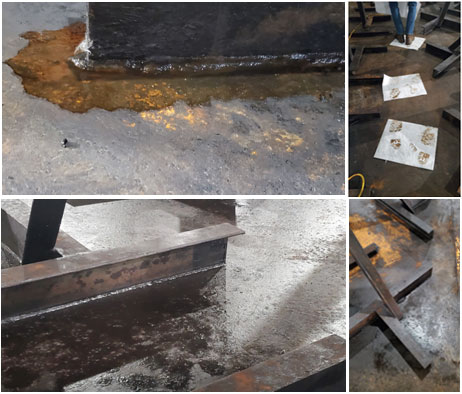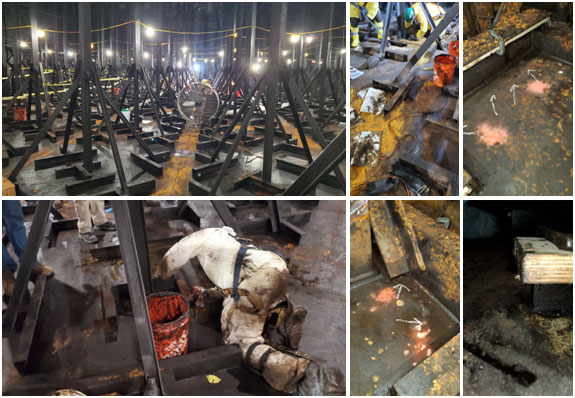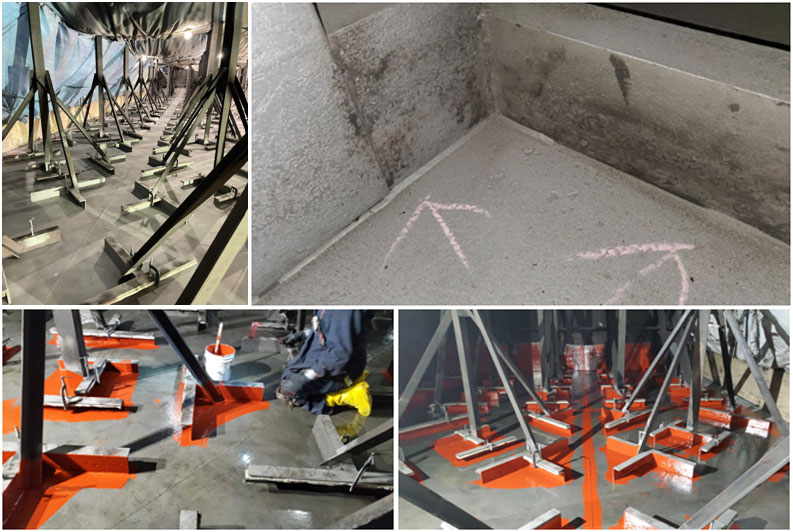Background:
A major urban utility provider was in the process of converting a No. 6 Fuel Oil tank into a Biodiesel tank. Their internal engineering team identified that Biodiesel is more corrosive than the No. 6 Fuel oil, so a coating system had to be installed to provide long-term corrosion protection. Biodiesel is significantly more aggressive towards polymeric coatings because of trace amounts of chemicals like Methanol, ethanol and ethylene glycol. Biodiesel also tends to have a higher water content than traditional hydrocarbon fuels.
Once the utility company identified several coating systems that were compatible with long-term immersion in Biodiesel, they moved forward with selecting a contractor for the project. The winning bidder was responsible for cleaning out the tank to remove all the remaining oil, then grit blasting the surface to the required cleanliness standard prior to application on the tank floor and up 24” on the walls of the tank.
Unfortunately, the contractor could not meet the cleanliness standard in the given timeframe due to the high viscosity of the oil and the complex geometry found inside the tank. After several attempts to clean the tank and meet the standard, the project was severely delayed and at risk of being canceled.
 Meeting Standards
Meeting Standards
As is typical in high-performance coating application projects, the project specification required a SSPC-SP 10/NACE No. 2 Near-White Metal finish, with a minimum 3 mil profile prior to applying the coating system. The standard states, “…the surface shall be free from visible oil, grease, dust, dirt, mill scale, rust, coating, oxides, corrosion products, and other foreign matter [when viewed without magnification].” However, neither the end user or the application contractor fully appreciated how the complex geometry of the tank internal, the large work scope and the high viscosity of the No. 6 fuel oil combined to make meeting this standard incredibly difficult and costly.
The tank being coated measured 195 ft. long by 145 ft. wide, and as it was designed to be “bomb-proof”, had approximately 84 column supports internally. Each of the column supports was stitch-welded with 6 – 8 angle supports (“crows feet”) on either end connecting it to both the tank roof and the tank floor. As such, the layout of the supports created high numbers of small grooves, sharp angles and difficult to reach areas, making the removal of oil prior to grit blasting extremely challenging.
Attempts to Clean the Tank
The contractor originally planned to use a commercially available degreaser along with a pressure washer and vacuum trucks to remove all oil from the tank floor and wall. After three attempts to pressure wash and clean the tank over the course of three months, the flat areas on the floor between the columns looked clean, but the hard to reach areas near and underneath the column support assemblies were still heavily contaminated with residual oil and there were many areas where the water from the pressure washing had not been removed effectively, causing it to then mix with the oil and settle to create a thin film.
The contractor then tried to manually clean the areas with wire brushes, rags and solvent wash. They were able to reduce the level of oil after this fourth cleaning, however this process was very time and labor intensive, required rigorous oversight and was still not successful in removing enough residual oil that grit blasting procedures could proceed. With no way to move forward and with the possibility of the project being canceled altogether, they decided to contact Advanced FRP Systems for guidance and an alternative solution.
Impact of Oil on the Substrate Prior to Coating
Traditional barrier coatings like an epoxy, polyurethane or vinyl ester do not stick well to an oil contaminated surface. Residual oil on a surface causes most liquids to bead up instead of wetting out the surface. Liquid applied coatings rely on physical adhesion to a rough substrate, which is why grit blasting is so critical. Oil contamination prevents the coating from wetting out the surface and filling in the profile created during grit blasting. This greatly reduces the adhesion of the coating. Very thick oils are even worse as they create a physical barrier layer between the coating and the substrate completely eliminating any adhesion of the coating. Coating systems that are applied without the proper adhesion values are prone to premature failure caused by the standard operating conditions for tanks, pipes and vessels.
New Direction and Verification
Advanced FRP had previously developed an oil-tolerant primer system, FRP 201 OT Primer, for use in applications with oil contaminated concrete. Designed to have significantly lower polarity prior to polymerization, the FRP 201 OT Primer can properly wet out the contaminated surface and provides excellent adhesion to the substrate. After polymerization, the polarity of the polymer increases significantly, allowing the coating to form chemical bonds with the more polar substrate. In many cases, the primer is able to dissolve trace amounts of surface oil and incorporate them into the polymer chain as a plasticizer.
As FRP 201 OT Primer had not been used previously on oil contaminated steel, the end user and contractor commissioned Advanced FRP to test and verify the performance of FRP 201 OT Primer on steel with varying levels of oil contamination. Upon receiving No. 6 fuel oil from the client, adhesion test panels were created and after some minor tweaks to the formulation, the FRP 201 OT Primer was able to consistently provide over 2,500 psi of adhesion, even on steel surfaces with heavy oil contamination prior to grit blasting.
The success of the adhesion test panels gave the end user the confidence to approve a test application in the actual tank. This was then followed by an on-site adhesion test done on three areas with varying levels of oil contamination. The intent of the testing was to ensure the FRP 201 OT provided adhesion in actual field conditions and to determine the acceptable level of oil contamination prior to blasting. The light, medium, and heavily contaminated sections all passed the adhesion testing with average adhesion values above 2,500 psi.
With the testing and verification process successfully completed and the project almost a year past the desired finish date, the end user, the contractor and Advanced FRP moved ahead with a new plan to incorporate the FRP 201 OT Primer into the application project and complete the project without further delay.
Installation and Project Completion
Due to the success of the FRP 201 OT Primer testing, the SSPC-SP 10 cleanliness standard requirement was removed. In its place, a rigorous cleaning and inspection plan was implemented that required the sign off of a third-party NACE Level 3 inspector, the contractor’s NACE Level 3 inspector and Advanced FRP’s on-site representation. The contractor divided the tank into nine sections, and went about diligently cleaning each section of the tank with hand tools, rags and solvent wash, removing any thick film residual oil and ensuring all hard to reach areas were cleaned to a “medium” to “light” contamination level. The inspection team would then inspect the entire section of the tank, including all the angled supports on the floor and wall of the tank, identify areas that required further remediation and only when all three parties agreed, approval was given to move forward with grit blasting to a minimum of 3 mil profile.
Once an area was successfully grit blasted and verified by the NACE Inspectors, a coat of the FRP 201 OT Primer was then installed. Once cured, the corners, angles, and difficult to reach areas were coated with a total film build of 30 mils of HP 300 GF, an immersion-grade epoxy coating. The HP 300 GF provides excellent resistance to biodiesel exposure and adhesion to the FRP 201 OT primer. After some initial issues with implementing the pre-blast cleaning and inspection plan, the contractor settled into a rhythm and each section was blasted, cleaned and coated in 5 – 7 working days before the crew would move on to the next section.
Once an area was successfully grit blasted and verified by the NACE Inspectors, the applicator set out to stripe coat all the corners, angles and difficult areas with the FRP 201 OT Primer prior to applying it to the entire floor and required areas on the wall. Once the 201 OT Primer cured, the application process (stripe coating, then applying to the entire required surface) was repeated with HP 300 GF, an immersion-grade coating that provides excellent resistance to biodiesel exposure and adhesion to the FRP 201 OT Primer. The HP 300 GF was applied to a minimum film build of 30 mils. After some initial issues with implementing the pre-blast cleaning and inspection plan, the contractor settled into a rhythm and each section was blasted, cleaned and coated in 5 – 7 working days before the crew would move on to the next section.
After the coating was installed, each section was checked for holidays using a high-voltage holiday tester. The complex geometry of the tank caused numerous pinholes and thin spots to show up during the testing of the first sections, particularly where the angled supports were welded to the floor and other hard to reach areas along the wall. Once this was identified, the contractor emphasized stripe coating all the corners and angles well. This enabled them to reduce the number of holidays and minimize the required time for re-work. Although the project was finished a year later than expected, the end-user was very happy with the final result and was confident that the coating system installed would provide decades of corrosion protection for this critical tank.



